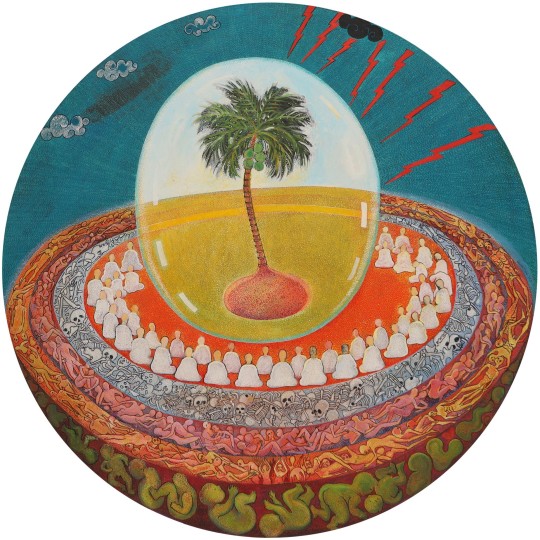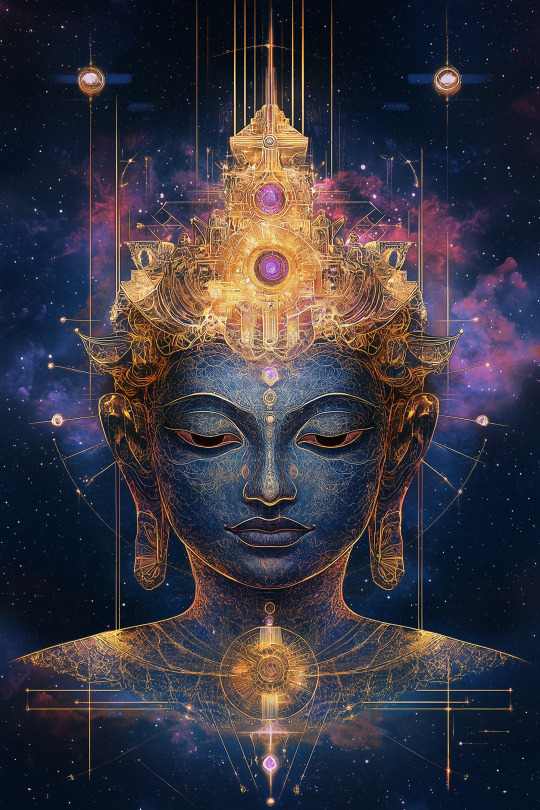#nibbana
Explore tagged Tumblr posts
Text

Sriwan Janehuttakarnkit — Nibbana in Samsara (oil on canvas, 2016)
897 notes
·
View notes
Text
"The word "suchness" describes reality as it is. Concepts and ideas are incapable of expressing reality as it is. Nirvana, the ultimate reality, cannot be described, because it is free of all concepts and ideas. Nirvana is the extinction of all concepts. It is total freedom. Most of our suffering arises from our ideas and concepts. If you are able to free yourself from these concepts, anxiety and fear will disappear. Nirvana, the ultimate reality, or God, is the nature of no-birth and no-death. It is total freedom. We need to touch this reality to leave behind the fear connected with the idea of birth and death."
-- Thich Nhat Hanh
5 notes
·
View notes
Text
I don't agree with perennialists that all religions lead to the same goal. Theravada buddhism leads to the cessation of suffering and transcendence, other religions only lead to union with a god at best. And union with deities is regarded as an inferior state compared to nirvana. Buddhism is so far the only religion in the world which deals extensively with suffering and explains in clear terms how to overcome it, while the other religions just ask you to have faith in a deity and to expect universal salvation after your death. There's an in-depth analysis of the world that is not found anywhere in any other religions except buddhism. Buddhism tells you that you can find unconditional happiness here and now by yourself, without relying on some external god to save you. So no, don't put buddhism on the same plane as other religions, it's just different.
1 note
·
View note
Text
The Path To Enlightenment
In bumbling through YouTube last night, I happened upon an extraordinary video. I say ‘extraordinary’ because the information it conveys is so unusually lucid – particularly given the subject of the video is one that is often misinterpreted and left unclear. The video covers the four Noble truths of the Buddhist path: the way to Nibbana – or enlightenment – and it’s well worth…
youtube
View On WordPress
#awareness#calm#dukkha#enlightenment#meditation#mindfulness#nibbana#stillness#suffering#vipassana#Youtube
0 notes
Text
youtube
Embrace Nibbana to reach enlightenment past the anger and rage.
0 notes
Text
Knowing and Seeing by Pa-Auk Tawya Sayadaw


Knowing and Seeing Knowing and Seeing is a set of precise and detailed instructions on realising Nibbāna in this very life as it is developed and practised at the Pa-Auk Forest Monastery in Myanmar. From the foreword: To achieve Nibbāna yogis must comprehend the aggregates, as impermanence, suffering, and non-self. As for the objects of Vipassanā meditation, they are not only the internal and external five aggregates, but also the five aggregates of past, future and present, gross and subtle, superior and inferior, far and near. Only after comprehending all of them penetratively as impermanence, suffering, and no-self, can yogis attain the noble paths. Then they continue to practise Vipassanā to attain the higher paths and fruitions up to Arahantship, whereby they are no longer subject to rebirth, and will attain final Nibbāna after death. Download the free ebook here (346 pages):

Knowing and Seeing
What is The Pa-Auk Forest Monastery?
The Pa-Auk Forest Monastery, also known as Pa-Auk Tawya, is a Theravāda Buddhist monastery located in the Pa-Auk Forest of Myanmar (Burma). It is one of the most renowned meditation centers in the country and is known for its comprehensive and detailed approach to meditation based on the Visuddhimagga, a classic meditation manual. Here are some key points about the Pa-Auk Forest Monastery: - Location: The monastery is situated in the Pa-Auk Forest near the town of Mawlamyine in Mon State, Myanmar. - Teachings: The primary meditation method taught at Pa-Auk is based on the Visuddhimagga (The Path of Purification), which provides detailed instructions on both samatha (tranquility) and vipassanā (insight) meditation practices. The monastery is known for its systematic and rigorous approach to meditation. - Venerable Pa-Auk Sayadaw: The monastery is under the guidance of the Venerable Pa-Auk Sayadaw, who is a highly respected meditation master in the Theravāda tradition. He has been instrumental in spreading the teachings of the Visuddhimagga to both Eastern and Western practitioners. - International Community: Due to its reputation, the Pa-Auk Forest Monastery attracts meditators from all over the world. As a result, it has a diverse community of monks, nuns, and laypeople from various countries. - Daily Routine: The daily routine at the monastery typically includes periods of meditation, chanting, alms rounds, and dhamma talks. There's a strong emphasis on maintaining silence and mindfulness throughout the day to support deep meditation practice. - Branch Monasteries: Over the years, several branch monasteries and meditation centers affiliated with Pa-Auk Tawya have been established in various countries, allowing more people to access the teachings and practices. - Lifestyle: The lifestyle at the monastery is simple and austere, in line with the monastic code of the Theravāda tradition. This simplicity is intended to minimize distractions and support the deepening of meditation practice. The Pa-Auk Forest Monastery continues to be a beacon for those seeking a thorough and traditional approach to Buddhist meditation. Read the full article
0 notes
Link
https://marmikmaharashtra.com/nibbana-method-of-diagnosis-of-diseases-faith-of-dr-nilesh-patil-and-dr-akesha-patil/
0 notes
Text
Pros:
scientist
doll rescuer
doll friend
judging from how she notices an abandoned doll and a somewhat abandoned person, observant
afford said abandoned people with her companionship
evolved from a long line of complicated people originating from a messed up individual and her complicated pet-tumor
has a name that means "mud". No grand and gorgeous and even "crystal clear water"-esque name. Just "mud."
Cons:
Don't know the full scope of her personality yet
I should not be showing favoritism yet I shall nat I SHALL NAT NOPE NOPE INVEST IN 32 DORO STOCKS!
-----
More Thoughts on the Mud Naming (i.e. why I love that she's called Doro):
Though not as grand or sweet or beautiful a name as, say, "Mizuha" and other water-related names in the Hayase bloodline, "Doro" is a name that, to me, is the most implicative of growth.
Of course, it's because I'm once again seeing this in a Buddhist view (Look, it's usually either this or The Scientist's view, man. You know what you signed up for when you read a ramble by KafkaoftheRubble, brutha.).
It's got to do with the lotus flower.
Lotuses are cherished in Indian religions and philosophy; Buddhism is one of them. It persists even after spreading to East Asia and other parts of the world.
The simplest reasoning is captured in an 11th-century (Song Dynasty) Chinese writer's text:
[...] 予独爱莲之出淤泥而不染——"I, however, especially love the lotus; for it grows from the mud untainted." (translation mine)
In Buddhism, the lotus symbolizes nibbana/nirvana/liberation (though also commonly translated as "enlightenment" in English). The mud symbolizes samsara—the cycle of suffering.
Buddhism stresses a lot on causal determinism. Everything is caused by something prior... not a chain of cause and effects, but a web. Nothing exists in a vacuum—not even something as "transcendent" as Nibbana. Hence, the mud is very important: the lotus flower, so "enlightened" as it were, cannot have arisen without the mud that sustained it.
In other words, enlightenment is caused by one who knows intimately what suffering is. One who is embedded in it. Suffering allows one to be awake and strive toward enlightenment and liberation.
There's a reason why in Buddhist thought, the human path [1] is the likeliest path to nibbana compared even to the Deva path. The Devas live in nice-ass places (comparable to heavens in other religions/myths), enjoy long-ass, nigh-immortal lives, and experience almost zero suffering. And yet it is precisely because of this minimal-to-no suffering that the Devas cannot become enlightened—they live in such comfort that they either mistakenly believe this is what life is all about, or that they experience zero impetus to strive for better.
[1] The human path, in comparison, has both shares of suffering and moments of comfort and pleasure. The latter is important because if one is constantly suffering, they cannot focus on anything beyond their pain... nor can they perform salutary actions (think how limited the moral choices would be for a person who's desperate and in pain). And yet, since the existence of suffering is also important if one hopes to be awake, the human path is the Middle Path among all Six Paths of Rebirth.
This is why I like Doro's name. Though a clone of Mizuha, strictly speaking, she can be considered as a rebirth of Hayase still. To me, her name hints at a humility and awareness the previous rebirths' names didn't imply. It's as if after so many rebirths and the cumulative growth contributed by each, "Hayase" is finally cognizant of "the mud" they are in.
And from the mud, a lotus may grow, liberated at last.
-
Thank you for reading my semi-ramble that I did not plan but came out of me anyway! Sidethoughts in tags!


i've only known her for one chapter and i'd die for her 🥺
#Doro should therefore be an even bigger step-up from Mizuha#I never said this out loud but I think if someone knows I actually resonate most with Left Hand Nokker out of all TYE characters#then they could guess that I actually adore Hayase's rebirths as one of the cyclic constants in these arcs#In Buddhism rebirths are akin to phases of one's life. Hence rebirths are themselves cumulative growths#Given the rock bottom Hayase and Left Hand started out this actually makes their growths-in-rebirths very poignant#as it illustrates the idea that yes; even the worst kind of people may attain Nibbana. They must first learn and#they will experience much suffering... as we all do. We call 'em the “human condition”#but if they strive for salutary actions—however small and however deluded it may be starting out—#these actions become meritorious causes toward better and better effects in each rebirth.#Better effects become better causes and less deluded origins of salutary actions. Then eventually they will lead to nibbana#fumetsu no anata e#小泥子 doro#fnae spoilers#fnae manga spoilers#fnae manga#another manga that deals heavily with cycle of samsara is JJK and that shit dives even deeper into it
15 notes
·
View notes
Text


“He who walks in the eightfold noble path with unswerving determination is sure to reach Nirvana.” - Buddha Nirvana (Nibbana) Talon Abraxas
36 notes
·
View notes
Text

Wise Attention: Yoniso
Manasikara in Theravada Buddhism - 01
lip Dependent Origi, ation by in estigating the ethe 2-
ageing and death through wise attention. In the Maha Sakyamuni Gotama sutta of the Samyutta Nikaya (collection of the Buddha's connected discourses), the Buddha has stated:
"Bhikkhus, before my enlightenment, while I was still a bodhisattva (Enlightenment being), it occurred to me:
"Alas, this world has fallen into trouble, in that it is born, ages, and dies, it passes away and is reborn, yet it does not understand the escape from this suffering led by aging-and-death. When will an escape be discerned from this suffering led by aging-and-death? Then, bhikkhus, it occurred to me: When what exists does aging-and-death come to be? By what is aging-and-death conditioned?
Then, bhikkhus, through wise attention, there took place in me a breakthrough by wisdom: When there is birth, aging-and-death comes to be; aging-and-death has birth as its condition". In the same way, the Buddha traced back the chain of causation by way of origin as far as ignorance, and then traced forwards the chain of causation from the cessation of ignorance to the cessation of old age and death, the cessation of the entire mass of suffering.
Wise Attention (yoniso manasikara)
Wise attention can be described as thinking in terms of causal relationships, such as the consequences of one's thoughts and actions, or exploration of the conditioned nature of phenomena which will lead to the development of insight or wisdom. It is an essential factor that will help a Buddhist disciple to progress through various stages of the Noble Eight-fold Path towards Nibbana - liberation from all suffering and the cycle of birth and death (samsara). In Buddhist literature it is also referred to as wise reflection, critical reflection, reasoned attention, wise consideration, systematic attention or analytical reflection among many other terms.
#buddha#buddhist#buddhism#dharma#sangha#mahayana#zen#milarepa#tibetan buddhism#thich nhat hanh#enlightenment spiritualawakening reincarnation tibetan siddhi yoga naga buddha
9 notes
·
View notes
Text
hello everyone i have published an improv ep my friend and i recorded in 2022 when i was still back in florida.
pls listen! if you want!
10 notes
·
View notes
Text

you won't find happiness in mental constructs
1 note
·
View note
Text
Wukong Sun: Black Legend (2024)



Date: December 26, 2024 Platform: PC Developer: Global Game Studio Publisher: globalgamestudio Genre: Adventure / Action / RPG Adaption: Retelling
Summary:
Embark on an epic Journey to the West in Wukong Sun: Black Legend! Step into the role of the immortal Wukong, the legendary Monkey King, as he battles through a chaotic world teeming with powerful monsters and untold dangers. Explore a story inspired by Chinese mythology, filled with action-packed battles, stunning environments, and legendary foes. Features: Unleash Legendary Power: Take control of Wukong's supercharged abilities and crazy fighting skills to crush all enemies standing in your way. Use strategy and skill to emerge victorious in the heat of battle. Conquer Four Chaos Maps: Adventure through iconic locations such as the Flower-Fruit Mountain, White Bone Cave, Accumulated Thunder Mountain, and Nibbana, each guarded by formidable bosses like the Bull Demon King, Princess Iron Fan, White Bone Demon, and even Tathagata Buddha’s hand! Thrilling Levels: Overcome diverse challenges in a wide range of levels filled with dynamic battles, hidden secrets, and mythical lore. Upgrade and Customize: Strengthen Wukong with powerful upgrades and unlock four distinct skins to suit your style of play. Immersive Mythological World: Dive into the chaos of a world inspired by ancient legends, blending captivating visuals with unforgettable storytelling.
Source: https://www.nintendo.com/us/store/products/wukong-sun-black-legend-switch/
Link: N/A
2 notes
·
View notes
Text
Mindfulness is the way to the Deathless (Nibbana)
Dhammapada Verses 21, 22 and 23 Samavati Vatthu
Appamado1 amatapadam2 pamado maccuno padam3 appamatta na miyanti4 ye pamatta yatha mata.5
Evam visesato natva appamadamhi pandita appamade pamodanti ariyanam gocare rata.6
Te jhayino7 satatika ni ccam dalhaparakkama phusanti dhira nibbanam8 yogakkhemam9 anuttaram.
Verse 21: Mindfulness is the way to the Deathless (Nibbana); unmindfulness is the way to Death. Those who are mindful do not die; those who are not mindful are as if already dead.
Verse 22: Fully comprehending this, the wise, who are mindful, rejoice in being mindful and find delight in the domain of the Noble Ones (Ariyas).
Verse 23: The wise, constantly cultivating Tranquillity and Insight Development Practice, being ever mindful and steadfastly striving, realize Nibbana: Nibbana, which is free from the bonds of yoga; Nibbana, the Incomparable!
tipitaka.net
3 notes
·
View notes
Text
shepherd ju peter, sengoku and imu (shepherd and the buddha

I had a vague memory of a story about Buddha debating with a shepherd. I did some research, and found the old references that I'd learned back in my A-level religious studies. Ajapala-nigrodha (अजपालन्यग्रोध) is a place nearby the Bodhi Tree under which it was said that the Buddha attained Nibbana (Enlightenment.) 'The name is said to mean 'In it's shadows, goatherds rest.' Perhaps then, the goats name is Ajapala. And also Sengoku was once closely connected to a shepherd.




Speaking of Shepherd, we also have the Warrior God of Agriculture: Shepherd Ju Peter. In Chinese mythology, Jupiter is associated with Sheep

sengoku's past may hold a connection to one of the gorosei, but

the word 'Imu' (イム) can be read as 'Buddha' (仏) too. All you have to do is to squeeze 'イム' together and you get '仏'.
the word may be a reference to imu and shepherd ju peter instead
@bottlepiecemuses
#one piece#op theory#op theories#saint shepherd ju peter#st. shepherd ju peter#imu nerona#op imu#op sengoku#op spoilers
2 notes
·
View notes
